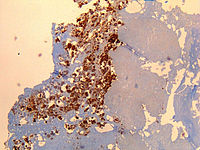
Photo from wikipedia
Knowledge of the prevalence and epidemiological determinants of tropical theileriosis in large ruminants, particularly in the asymptomatic carrier, is crucial for designing and implementing effective host-specific control measures. This study… Click to show full abstract
Knowledge of the prevalence and epidemiological determinants of tropical theileriosis in large ruminants, particularly in the asymptomatic carrier, is crucial for designing and implementing effective host-specific control measures. This study aimed to estimate the seroprevalence of tropical theileriosis in asymptomatic cattle and water buffaloes and identify the potential risk factors of theileriosis in large ruminants raised under smallholder-production system in Egypt. A cross-sectional study was conducted in five districts of the Sharkia governorate from March 2019 to February 2020. In total, 350 serum samples were collected from cattle and water buffaloes under smallholder-production system and tested for Theileria annulata antibodies using the indirect antibody fluorescence test (IFAT). Data on species, host characteristics, presence of ticks, season, and districts were collected at sampling using a questionnaire. A multivariable mixed-effects logistic regression model was built to determine the potential risk factors associated with T. annulate seropositivity of the animals. The overall apparent seroprevalence of T. annulata in 350 tested animals was 70%. In the univariable analyses, cattle compared to buffaloes, younger animals compared to older ones, animals with ticks on their bodies, and warmer seasons were all associated with a higher likelihood of seropositive results in the study population while sex of the animals was not associated with seropositivity. The final multivariable model showed that animals with ticks on their bodies had 3.5× higher odds of seropositivity than those with no ticks (P < 0.001), and warmer seasons were associated with the higher odds of infection compared to winter (P = 0.003). The high seroprevalence of tropical theileriosis in the study region indicates that the disease is endemic among smallholders of large ruminants. The identified risk factors of T. annulata-seropositivity in asymptomatic carrier animals provides evidence-based guidance for adopting effective intervention measures.
Journal Title: Frontiers in Veterinary Science
Year Published: 2022
Link to full text (if available)
Share on Social Media: Sign Up to like & get
recommendations!